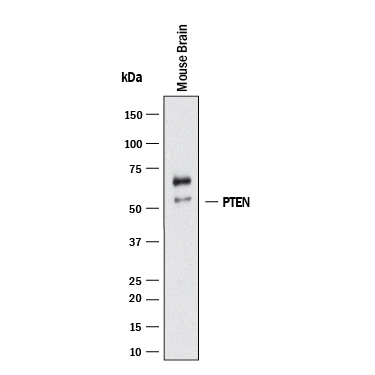Human/Mouse PTEN Antibody Summary
Thr2-Val403
Accession # P60484
Applications
Please Note: Optimal dilutions should be determined by each laboratory for each application. General Protocols are available in the Technical Information section on our website.
Scientific Data
 View Larger
View Larger
Detection of Mouse PTEN by Western Blot. Western blot shows lysates of 3T3‑L1 mouse embryonic fibroblast adipose-like cell line and C2C12 mouse myoblast cell line. PVDF membrane was probed with 2 µg/mL of Mouse Anti-Human/Mouse PTEN Monoclonal Antibody (Catalog # MAB847R) followed by HRP-conjugated Anti-Mouse IgG Secondary Antibody (HAF018). A specific band was detected for PTEN at approximately 54 kDa (as indicated). This experiment was conducted under reducing conditions and using Western Blot Buffer Group 1.
 View Larger
View Larger
Detection of Mouse PTEN by Western Blot. Western blot shows lysates of mouse brain. PVDF membrane was probed with 2 µg/mL of Mouse Anti-Human/Mouse PTEN Monoclonal Antibody (Catalog # MAB847R) followed by HRP-conjugated Anti-Mouse IgG Secondary Antibody (HAF018). A specific band was detected for PTEN at approximately 54 kDa (as indicated). This experiment was conducted under reducing conditions and using Western Blot Buffer Group 1.
 View Larger
View Larger
Detection of PTEN in Human U937 cell line by Flow Cytometry. Human U937 histiocytic lymphoma cell line was stained with Mouse Anti-Human/Mouse PTEN Monoclonal Antibody (Catalog # MAB847R, filled histogram) or isotype control antibody (MAB002, open histogram), followed by Phycoerythrin-conjugated Anti-Mouse IgG F(ab')2 Secondary Antibody (F0102B). To facilitate intracellular staining, cells were fixed with Flow Cytometry Fixation Buffer (FC004) and permeabilized with Flow Cytometry Permeabilization/Wash Buffer I (FC005). Staining was performed using our protocol for Staining Intracellular Molecules.
 View Larger
View Larger
Western Blot Shows Human PTEN Specificity by Using Knockout Cell Line. Western blot shows lysates of HeLa human cervical epithelial carcinoma cell line and human PTEN knockout cell line. PVDF membrane was probed with 2 µg/mL of Mouse Anti-Human/Mouse PTEN Monoclonal Antibody (Catalog # MAB847R) followed by HRP-conjugated Anti-Mouse IgG Secondary Antibody (HAF018). A specific band was detected for PTEN at approximately 54 kDa (as indicated) in the parental HeLa human cervical epithelial carcinoma cell line, but is not detectable in knockout HeLa human cervical epithelial carcinoma cell line. GAPDH (Catalog # MAB5718) is shown as a loading control. This experiment was conducted under reducing conditions and using Western Blot Buffer Group 1.
Reconstitution Calculator
Preparation and Storage
- 12 months from date of receipt, -20 to -70 °C as supplied.
- 1 month, 2 to 8 °C under sterile conditions after reconstitution.
- 6 months, -20 to -70 °C under sterile conditions after reconstitution.
Background: PTEN
The tumor suppressor gene PTEN (phosphatase and tensin homolog deleted on chromosome 10), also known as MMAC1 (mutated in multiple advanced cancers 1), encodes a phosphatase that contains the catalytic signature motif (HCxxGxxRS/T) found in all members of the protein tyrosine phosphatase family. In vitro, the recombinant PTEN has both lipid phosphatase and protein phosphatase activities (1, 2). Interestingly, accumulating evidence has shown that the tumor suppressor activity of PTEN relies on its ability to dephosphorylate phosphatidylinositol (3,4,5)-triphosphate specifically at position 3 of the inositol ring (3). This activity reduces the levels of phosphatidylinositol (3,4,5)-triphosphate which is specifically produced from phosphatidylinositol (4,5)-diphosphate by PI 3-kinase upon activation by a variety of stimuli. Therefore, PTEN antagonizes PI 3-kinase-induced downstream signaling events and cellular processes including cell growth, apoptosis and cell motility. In vivo, the importance of PTEN catalytic activity in its tumor suppressor functions is underscored by the fact that the majority of PTEN missense mutations detected in tumor specimens target the phosphatase domain and cause a loss in PTEN phosphatase activity (4).
- Maehama, T. and J. Dixon (1998) J. Biol. Chem. 273:13375.
- Das, S. et al. (2003) Proc. Natl. Acad. Sci. USA 100:7491.
- Myers, M. et al. (1998) Proc. Natl. Acad. Sci. USA 95:13513.
- Waite, K. and C. Eng (2002) Am. J. Hum. Genet. 70:829.
Product Datasheets
FAQs
No product specific FAQs exist for this product, however you may
View all Antibody FAQsReviews for Human/Mouse PTEN Antibody
There are currently no reviews for this product. Be the first to review Human/Mouse PTEN Antibody and earn rewards!
Have you used Human/Mouse PTEN Antibody?
Submit a review and receive an Amazon gift card.
$25/€18/£15/$25CAN/¥75 Yuan/¥2500 Yen for a review with an image
$10/€7/£6/$10 CAD/¥70 Yuan/¥1110 Yen for a review without an image




